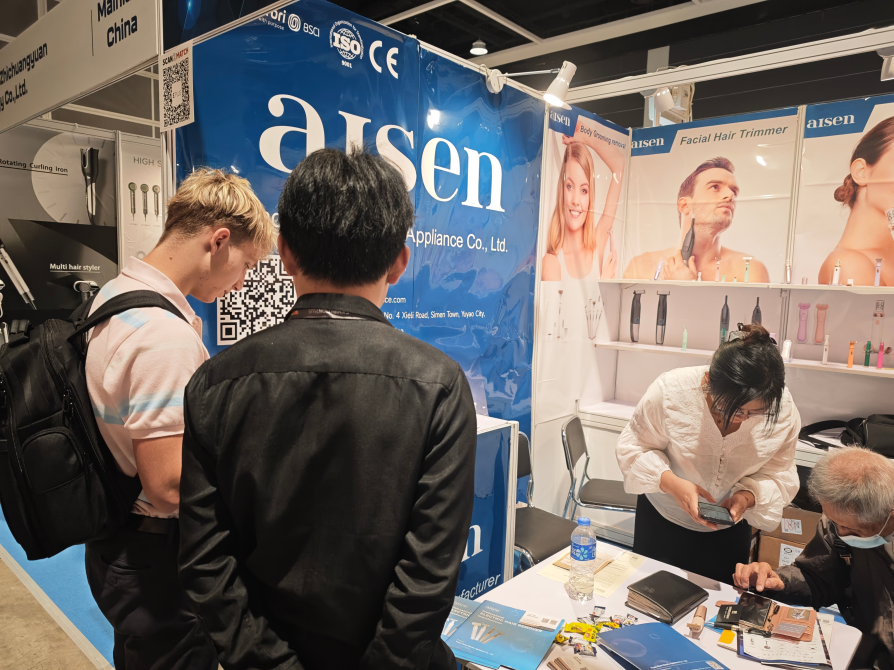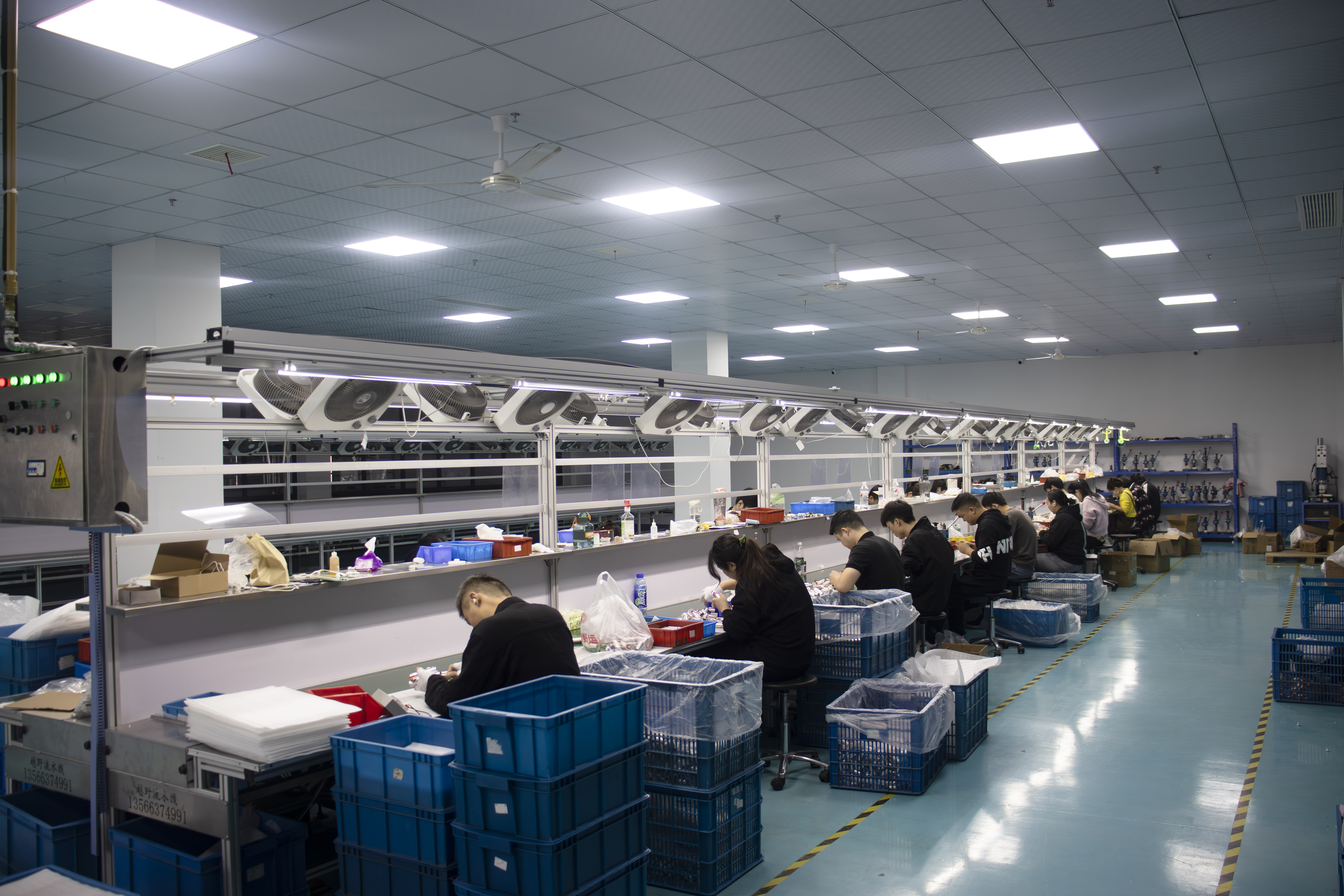News Category:
Key Words:
-
May 09,2025
Let You Know About Yuyao Aisen
Yuyao Aisen Electric Appliance Co., Ltd. is a comprehensive high-tech enterprise located in Ningbo, Zhejiang Province, focusing on the design and production of various styles of electric hair removers, integrating R&D, design, manufacturing, quality control, inspection and packaging, logistics and distribution, brand marketing and after-sales service. The company supports OEM/ODM service with complete qualifications, ISO 9001, BSCI, CE, ROHS, EMC, appearance patents, invention patents, utility model and product test reports.
VIEW FULL ARTICLE -
Apr 21,2025
Yuyao Aisen Electric Appliance Co., Ltd. Makes a Splash at Hong Kong Electronics Fair with Innovative Personal Care Appliances
Yuyao Aisen Electric Appliance Co., Ltd. recently took center stage at the Hong Kong Electronics Fair, a globally renowned event that serves as a launchpad for the latest and greatest in the electronics industry. Held at the bustling Hong Kong Convention and Exhibition Centre, the fair attracted a staggering number of exhibitors and visitors from across the globe, creating a vibrant atmosphere teeming with innovation and business opportunities. Yuyao Aisen's booth was a focal point at the fair, drawing in a steady stream of passersby with its eye - catching display of advanced personal care home appliances. The company's commitment to innovation and quality was on full display, with products designed to meet the diverse needs of consumers seeking efficient and convenient hair removal solutions. Revolutionary Electric Hair Removers Steal the Show Yuyao Aisen's electric hair removers were the star attraction at its booth. These devices are engineered with cutting - edge technology to provide a pain - free and effective hair removal experience. The hair removers feature a high - speed rotating blade system, capable of quickly and precisely removing hair from various parts of the body. Whether it's unwanted facial hair, leg hair, or hair in more sensitive areas, Yuyao Aisen's hair removers are up to the task. One of the key highlights of the hair removers is their ergonomic design. The devices are shaped to fit comfortably in the user's hand, allowing for easy maneuverability and control during use. This not only enhances the user experience but also ensures that even hard - to - reach areas can be effectively groomed. Additionally, the hair removers are equipped with a long - lasting battery, providing users with extended usage time without the need for frequent recharging. This makes them perfect for both at - home use and on - the - go grooming. For those looking for a more targeted hair removal solution, Yuyao Aisen also offers specialized facial hair trimmers. This compact device is designed specifically for grooming facial hair, such as mustaches, beards, and sideburns. The facial hair trimmer comes with adjustable settings, allowing users to customize the length of their hair according to their personal preferences. It features a precision - engineered blade that can trim even the finest hairs, providing a clean and sharp look. Interactive Product Demonstrations Engage Visitors To showcase the capabilities of its products, Yuyao Aisen's booth featured interactive product demonstrations throughout the fair. Company representatives were on hand to guide visitors through the features and functions of the electric hair removers and facial hair trimmers. They demonstrated how the devices work, highlighting their ease of use and effectiveness. Visitors were given the opportunity to try out the products for themselves, experiencing firsthand the smooth and efficient hair removal process. Many were impressed by the performance of the hair removers, commenting on how quickly and painlessly they were able to remove hair. The interactive demonstrations not only helped to build trust in the products but also provided valuable feedback to the company, which can be used to further improve its offerings. Positive Feedback and Growing Interest from the Market The response to Yuyao Aisen's products at the Hong Kong Electronics Fair was overwhelmingly positive. Potential customers, including distributors, retailers, and individual consumers, expressed a strong interest in the company's electric hair removers and facial hair trimmers. Many were attracted by the innovative design, high - quality construction, and competitive pricing of the products. Distributors and retailers saw the potential for these products in their respective markets and were eager to explore partnership opportunities with Yuyao Aisen. They recognized the growing demand for personal care appliances that offer both functionality and style, and believed that Yuyao Aisen's products could fill a niche in the market. Individual consumers, on the other hand, were drawn to the products for their practicality and effectiveness. They appreciated the fact that the hair removers and facial hair trimmers could provide a convenient and affordable alternative to traditional hair removal methods, such as waxing or using depilatory creams. Looking Ahead: Expanding Market Reach and Product Development With the success of its participation in the Hong Kong Electronics Fair, Yuyao Aisen Electric Appliance Co., Ltd. is well - positioned to expand its market reach and further develop its product line. The company plans to build on the momentum generated at the fair by strengthening its relationships with existing partners and forging new ones. In terms of product development, Yuyao Aisen will continue to invest in research and innovation to stay ahead of the competition. The company aims to introduce new features and improvements to its electric hair removers and facial hair trimmers, based on the feedback received at the fair. This may include enhancing the battery life, improving the blade technology, or adding more customization options for users. As Yuyao Aisen looks towards the future, it is confident that its commitment to quality, innovation, and customer satisfaction will enable it to make a significant impact in the global personal care appliance market. The company is excited about the opportunities that lie ahead and is dedicated to bringing more innovative and high - performance products to consumers around the world.
VIEW FULL ARTICLE -
Mar 03,2025
Explore Yuyao Aisen's High-Tech Women's Grooming Devices at the 2025 Hong Kong Electronics Fair
2025 Hong Kong Electronics Fair: A Global Platform for Innovation The 2025 Hong Kong Electronics Fair (Spring Edition), organized by the Hong Kong Trade Development Council (HKTDC), is set to take place from April 13 to April 16, 2025, at the Hong Kong Convention and Exhibition Centre (HKCEC). As one of the world’s leading trade fairs in the electronics industry, this event attracts exhibitors and buyers from across the globe, showcasing cutting-edge technology, innovative products, and the latest trends in consumer electronics, home appliances, and electronic components. A Premier Event for the Electronics Industry The Hong Kong Electronics Fair serves as an essential platform for manufacturers, suppliers, and buyers to connect, explore business opportunities, and exchange industry insights. With thousands of exhibitors from various sectors, the fair presents a diverse range of products, including smart home devices, audio-visual equipment, wearable technology, robotics, and artificial intelligence-driven solutions. The Tech Hall, a key highlight of the fair, features thematic zones such as the Connected Home, Robotics & Unmanned Tech, Virtual Reality, and Wearable Electronics, reflecting the rapid advancements in modern technology. In addition to product showcases, the fair also hosts technology forums, startup pitching sessions, and networking events, providing attendees with valuable opportunities to engage with industry leaders, investors, and potential business partners. These activities help foster innovation and collaboration, strengthening Hong Kong’s position as a global hub for electronic trade and development. Yuyao Aisen Electric Appliance Co., Ltd. at the 2025 Hong Kong Electronics Fair Yuyao Aisen Electric Appliance Co., Ltd., a company specializing in the production of high-quality electrical appliances and personal care devices. With a strong reputation for innovation and reliability, Aisen has been a trusted manufacturer in the industry for years, supplying products to both domestic and international markets. Yuyao Aisen Electric Appliance Co., Ltd. will be exhibiting at Booth 5E-C09, where they will showcase their latest personal care products, specifically designed for women’s grooming needs. The company is committed to providing high-performance products that meet global safety and quality standards, ensuring durability and users’ satisfaction. At the exhibition, Aisen will introduce their latest women’s shavers and hair removal devices, featuring ergonomic designs, advanced blade technology, and skin-friendly materials. These products are designed to offer a comfortable and efficient grooming experience, catering to modern consumers who seek convenience and effectiveness in personal care solutions. Why Visit Hong Kong Electronics Fair? Industry professionals, distributors, and potential buyers visiting the Hong Kong Electronics Fair should not miss the opportunity to explore Yuyao Aisen Electric Appliance Co., Ltd.’s latest innovations at Booth 5E-C09. The company’s representatives will be available to discuss product features, customization options, and bulk order opportunities. Visitors will also have the chance to experience live demonstrations, gaining a firsthand look at the functionality and benefits of their personal care products. With the rising demand for high-quality personal care devices, Yuyao Aisen Electric Appliance Co., Ltd. continues to focus on technological innovation, user comfort, and safety. Their participation in the Hong Kong Electronics Fair underscores their commitment to delivering premium grooming solutions for women, meeting the needs of a growing global market. Welcome global partners and consumers to visit Booth 5E-C09 at the Hong Kong Convention and Exhibition Centre from April 13 to 16, and experience the innovative achievements of Yuyao Aisen Electric Appliance Co., Ltd.
VIEW FULL ARTICLE -
Feb 28,2025
Yuyao Aisen Electric Appliance Co., Ltd.: Professional Manufacturing System Ensures Hair Remover Quality
Yuyao Aisen Electric Appliance Co., Ltd. delivers high-precision hair removal device manufacturing solutions through standardized production processes and full-chain quality control. Its 10,000-square-meter production base in Ningbo integrates R&D, manufacturing, and logistics to provide one-stop services for global clients. Standardized Workshop Management The workshop features light-blue epoxy flooring with yellow demarcation lines, clearly defining work areas and material channels. Components are categorized in blue storage bins, while assembly workstations are equipped with shadowless lighting and industrial ventilation systems. Rear multi-tiered shelves store production materials, synchronized with control terminals to monitor real-time material usage and minimize downtime. Technical Validation Capabilities The company’s laboratory conducts rigorous testing on core components, including motor stability, temperature control accuracy, and noise reduction. Leveraging patented technologies, Aisen offers customized solutions such as structural optimization and heat dissipation improvements to meet diverse regulatory and market requirements. Adaptable Service Model With modular production lines, the factory enables rapid product specification adjustments for small-batch, high-variability orders. The technology showcase room displays CE/ROHS-certified models featuring quick-disassembly structures and smart sensors, helping clients accelerate market validation. Currently, Aisen earning industry recognition for its consistent product quality driven by systematic production management.
VIEW FULL ARTICLE -
Jun 17,2024
Yuyao Aisen Electric Appliance Co., Ltd.
Yuyao Aisen Electric Appliance Co., Ltd. is an enterprise that produces beauty and hair equipment such as shavers, razors, eyebrow trimmers, and hair pluckers. The company has an integrated enterprise that integrates product development, design, production, and sales. In addition to developing products, it can also undertake ODM/OEM orders. Our company adheres to innovative development concepts and creates products that meet market demands. We have a scientific management system and serve our customers with the philosophy of quality and integrity first. We welcome friends from all walks of life to visit, guide, and negotiate business.
VIEW FULL ARTICLE







